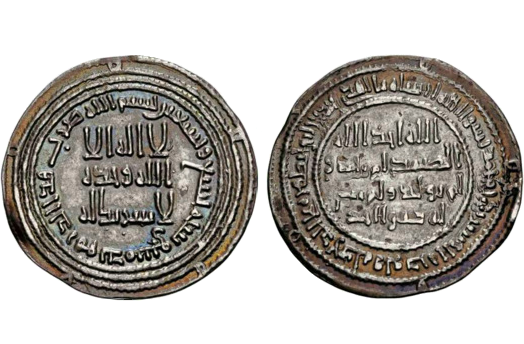
about ancient nomos
Ancient Nomos Art is a museum of galleries exhibiting ancient coins and ancient mint maps. The coin gallery displays the diverse art and history of hand-crafted ancient Greek, Roman, Byzantine, Persian and Medieval coinage. The ancient mints mapping gallery features Greek, Roman, Byzantine, Asia Minor and Medieval mint city regions and territories. Visitor's are welcome to explore, study and enjoy Ancient Nomos Art.

Islamic, Umayyad – 717 AD
Damascus Dirham
From Ancient Galleries

Obverse: In Arabic: "There is no deity except Allah alone. He has no equal..." See below for additional Arabic text references.
Reverse: In Arabic: "Allah is one Allah is eternal he did not beget was not..." See below for additional Arabic text references.
LEGEND
Obverse center legend (read right to left):
![]()
“There is no deity except [the one] Allah alone. He has no equal.”; in three lines. Outer legend in circumference within beaded borders:
![]()
“In the name of God. This dirham was struck in Damascus in the year nine and ninety.”; all within a triple pelleted border, with 5 outer annulets within a fourth pelleted border.
Reverse center legend:
![]()
“Allah is one Allah is eternal he did not beget and was not begotten and there was not anyone equal to Him.”; in four lines; within single beaded border.
Legend in circumference between beaded borders:
![]()
“Mohammed prophet of Allah was sent with guidance and truth to bring enlightenment to all religions even if the polytheists abhor it.”; all within a pelleted border, 5 annulets within an outer pelleted border.
Medieval Islamic coinage developed slowly from the influences of Sassanian Empire drachm types (see Husrav II hemidrachm), Byzantine miliaresion types (see Byzantine miliaresion coinage), and finally into the characteristically Islamic coinage seen above. The defining Islamic design character was the all Arabic legend inscriptions, without imagery. The transition was slower in the north Caspian region of Tabaristan where bilingual Pahlavi and Arabic coins and imagery continued for another 100 years (see Tabaristan hemidrachm). The early medieval Islamic coins were called the dirham and were similar, in both size and weight, to the Byzantine solidus. The Islamic coin obverse removed all images and figures of the emperors and deity, replaced with text only. The obverse text typically begins with the three line phase, “There is no deity except [the one] Allah alone. He has no equal.” Typically, surrounding the outer margin design, is the testimony text to Islam and mention of the mint city and date, all written in Arabic. The above dirham specimen was struck during the ninety ninth year AH (Anno Hegirae), from the time Mohammed fled Mecca in 622 AD. This dirham is a ‘purely Islamic’ coin struck in the mint city of Damascus, Syria. This was a time when Muslims were still a minority in Damascus and the majority of Arabs were either Pagans, Zoroastrians or Christians. The artful calligraphic Islamic coinage are of striking simplicity with beautifully engraved legend scripts. The uncompromisingly Islamic legend inscriptions were to become the basis of a very stable system of coinage whose weight, size and fineness was strictly maintained in accordance with the Qur’anic guidelines and precepts. These coin types quickly became a obvious symbol of Islam throughout the medieval Muslim world. The type lasted unchanged until the fall of the Umayyad caliphate in AH 132, and is a remarkable tribute to the very coordinated and enduring power of ‘Abd al-Malik’s original design concept that 3 of the 4 inscriptions, on the earliest of fully Islamic dirhams, are virtually identically inscribed on the last remaining late medieval Abbasid issues six centuries later.
DOCUMENTATION
Value: Dirham. Metal: AR Silver. Weight: 2.87 grams. Mint: Dimashq (Damascus) mint under the Umayyad Caliphate, Suleiman ibn ‘Abd al-Malik through ‘Umar ibn Abd al-Aziz. Date: AH 99 (717/8 AD). AD.
Attribution: Michel G. Klat, 343; Stephan Album, Checklist of Islamic Coins, 3rd Ed., 131 and 133; ICV 266. Photo courtesy CNG.
Legend, Documentation and Attribution
